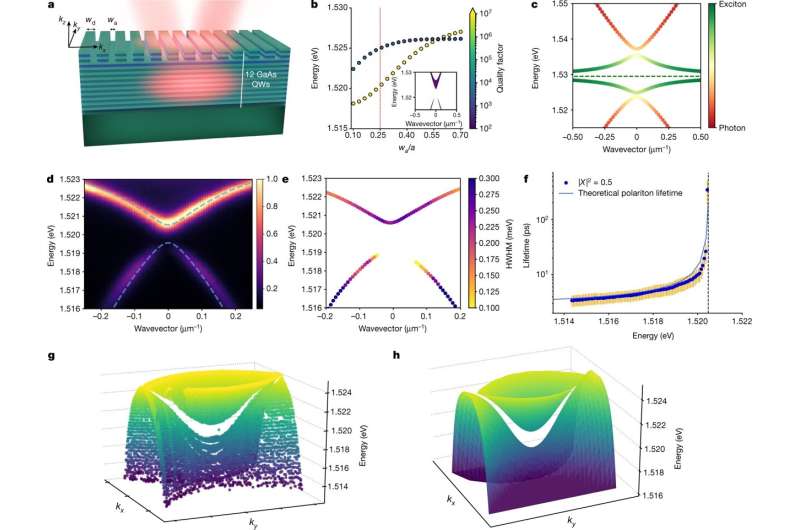Polariton BIC. a, Representation of the polariton waveguide with partially etched 1D lattice. b, Dependence of the upper and lower band extrema in kx = 0 on the grating air fraction (wa/a), with colours corresponding to the Q factor, as calculated by FDTD. Inset, calculated dispersion of grating modes (without exciton resonance); the line thickness represents the width of the corresponding photonic resonances for wa = 0.25a (red vertical line). c, Polariton dispersion as a function of kx in the energy range around the excitonic transition (green dashed line), calculated from a coupled oscillators model: the FDTD results of the photonic components are coupled to the excitonic resonance; the colours are a linear representation of the excitonic fraction for each mode between 0 (photon) and 1 (exciton). d, Angle-resolved photoluminescence emission under non-resonant excitation from a grating with a pitch a ≈ 240 nm and fill factor FF ≈ 0.7. The dark spot at E ≈ 1.519 eV on the lower polariton branch comes from the polariton BIC. The coupled oscillators model (blue dashed line) is used to fit the polariton dispersion, as in c. e, Experimentally extracted peak energies and corresponding HWHM (colour scale) from the two polariton modes visible in d as a function of kx. The points closest to kx ≈ 0 cannot be characterized, owing to the lack of signal from the dark state. f, Energy-resolved lifetime of propagating polaritons from the branch hosting the BIC mode that corresponds to the 0.5 exciton fraction (|X|2). Error bars (yellow) are explicitly reported, with increasing size on approaching the BIC energy (vertical dashed line). g, Dispersion of the polariton modes as a function of kx and ky, extracted from experimental spectra. The dispersion of the lower branch clearly forms a saddle, with a minimum along ky and a maximum along kx. h, Calculated polariton dispersion along kx and ky, obtained by the coupled oscillators model, as in c and d. The colours in g, h correspond to the energy axis, increasing from dark to light. Credit: Nature (2022). DOI: 10.1038/s41586-022-04583-7
A team of physicists from CNR-Nanotec in Lecce, Università di Pavia, Princeton University and Université de Lyon has demonstrated Bose-Einstein condensation using a planar waveguide where semiconductor quantum wells were strongly coupled to a bound state in a continuum (BIC). In their paper published in the journal Nature, the group describes how they designed and built a BIC supported waveguide and used it to demonstrate polariton Bose-Einstein condensation.
BICs are topological states in a quantum system that have unique properties—their energy is in the spectrum of modes that propagate in the space surrounding them. They do not interact with other states in a continuum, and their energy, which is deemed real, has an infinite Q factor. They also cannot radiate into a far field. Such states can exist in acoustic, electronic and photonic systems. In this new effort, the researchers were working with them in a photonic system, where crystals are used to improve their non-linear effects.
The work by the group involved use of the properties of a BIC to demonstrate polariton Bose-Einstein condensation (where a gas cools to near absolute zero forming a new state of matter) in a planar waveguide (a device that guides light in a vertical direction.)
In their work, the researchers built a waveguide using 12 layers of gallium arsenide—each layer was separated by barriers. The five layers at the top were then etched with a 1D grating that was designed to ensure a resonant BIC state with the excitation of quantum wells in the layers. Doing so also ensured that the matter and light were strongly coupled. This led to the formation of exciton-polaritons that, because of the BIC, were localized and had a linewidth that was infinitely narrow.
The researchers then ran their device using laser pulses aimed at the waveguide and in so doing showed polariton Bose-Einstein condensation—they observed doubly-peaked emissions near the BIC edges, the linewidth growing narrower and the appearance of a blueshift. They also showed that the BIC properties seen by the polaritons were both above and below the threshold level of excitation associated with the condensation.
More information: V. Ardizzone et al, Polariton Bose–Einstein condensate from a bound state in the continuum, Nature (2022). DOI: 10.1038/s41586-022-04583-7
Journal information: Nature
© 2022 Science X Network
























